
Pierluca Zizzi is an Italian game designer, inventor and co-author of board games such as Asgard, Signorie and Tang Garden. He is a writer, game design teacher, and lecturer on consciousness development topics.

Pierluca Zizzi is an Italian game designer, inventor and co-author of board games such as Asgard, Signorie and Tang Garden. He is a writer, game design teacher, and lecturer on consciousness development topics.
He was born in Turin in 1970 and graduated from the Polytechnic of Turin.
Zizzi began working as an architect.
After ten years, he turned to games. He collaborated with Italian authors, such as Andrea Chiarvesio, Martino Chiacchiera, Francesco Testini and others.[ citation needed ]
His design style inserts strong narrative and setting elements into the rules structure (Dark Tales, Similo, and 3 Secrets). His games range from simple to complex. He loves fantastic or shrouded-in-mystery and investigation settings. Several of his projects have been successful on Kickstarter such as Barbarians: The Invasion, Tang Garden and others. [1]
In 2019, he began teaching game design at the International School of Comics in Turin. [2]
Pierluca Zizzi is a researcher in the evolution of consciousness, and a writer. [3] He is the author of the book Divinare per Tutti and a series of cards decks for divination (Ascension Tarot, Infinity Tarot, Egyptian Tarot, Folk cards of destiny, Medieval fortune telling cards, Opposition Tarot in 2021 and others). [4] [ clarification needed ]
He is the author of the books Geometria Sacra and Sacred Energia Sacra, the first two volumes of a tetralogy.
Beginning in 2015, he attended conferences on symbolism, intelligent energy of places, modern initiations and human paradigm change. He has been interviewed in many webinars and television broadcasts. [5] [6]
This section of a biography of a living person does not include any references or sources .(July 2021) |
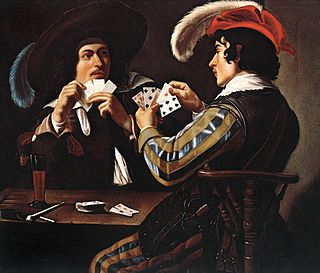
A card game is any game using playing cards as the primary device with which the game is played, be they traditional or game-specific. Countless card games exist, including families of related games. A small number of card games played with traditional decks have formally standardized rules with international tournaments being held, but most are folk games whose rules may vary by region, culture, location or from circle to circle.
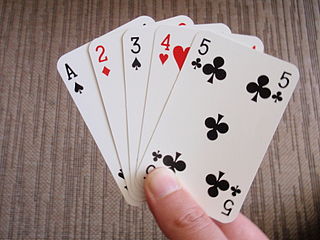
A playing card is a piece of specially prepared card stock, heavy paper, thin cardboard, plastic-coated paper, cotton-paper blend, or thin plastic that is marked with distinguishing motifs. Often the front (face) and back of each card has a finish to make handling easier. They are most commonly used for playing card games, and are also used in magic tricks, cardistry, card throwing, and card houses; cards may also be collected. Some patterns of Tarot playing card are also used for divination, although bespoke cards for this use are more common. Playing cards are typically palm-sized for convenient handling, and usually are sold together in a set as a deck of cards or pack of cards.

The tarot is a pack of playing cards, used from at least the mid-15th century in various parts of Europe to play card games such as Tarocchini. From their Italian roots, tarot playing cards spread to most of Europe evolving into a family of games that includes German Grosstarok and modern games such as French Tarot and Austrian Königrufen. In the late 18th century, French occultists made elaborate, but unsubstantiated, claims about their history and meaning, leading to the emergence of custom decks for use in divination via tarot card reading and cartomancy. Thus there are two distinct types of tarot pack in circulation today: those used for card games and those used for divination. However, some older patterns, such as the Tarot de Marseille, originally intended for playing card games, are occasionally used for cartomancy.

The Major Arcana are the named or numbered cards in a cartomantic tarot pack, the name being originally given by occultists to the trump cards of a normal tarot pack used for playing card games. There are usually 22 such cards in a standard 78-card pack, typically numbered from 0 to 21. The name is not used by tarot card game players.

The Rider–Waite Tarot is a widely popular deck for tarot card reading. It is also known as the Waite–Smith, Rider–Waite–Smith, or Rider Tarot. Based on the instructions of academic and mystic A. E. Waite and illustrated by Pamela Colman Smith, both members of the Hermetic Order of the Golden Dawn, the cards were originally published by the Rider Company in 1909. The deck has been published in numerous editions and inspired a wide array of variants and imitations. It is estimated that more than 100 million copies of the deck exist in more than 20 countries.

The Magician (I), also known as The Magus or The Juggler, is the first trump or Major Arcana card in most traditional tarot decks. It is used in game playing and divination; in the English-speaking world, the divination meaning is much better known.

Michael Austin Stackpole is an American science fiction and fantasy author best known for his Star Wars and BattleTech books. He was born in Wausau, Wisconsin, but raised in Vermont. He has a BA in history from the University of Vermont. From 1977 on, he worked as a designer of role-playing games for various gaming companies, and wrote dozens of magazine articles with limited distribution within the industry. He lives in Scottsdale, Arizona.

Tsathoggua is a supernatural entity in the Cthulhu Mythos shared fictional universe. He is the creation of American writer Clark Ashton Smith and is part of his Hyperborean cycle.

Arcanum: Of Steamworks and Magick Obscura is a 2001 role-playing video game developed by Troika Games and published by Sierra On-Line for Microsoft Windows. The game's story takes place within a fantasy setting currently undergoing a transformation from its own industrial revolution, in which magic competes against technological gadgets, and focuses on the efforts of a zeppelin crash survivor to find out who attacked the vessel, ultimately discovering a plot by an ancient power to return to the world and cause chaos. The game, conducted from an isometric perspective and within an open world, offers players the opportunity to craft their protagonist with a variety of skills, including the option to be gifted in magic or use guns and gadgets to combat enemies, and complete quests in different ways.

The Hyborian Age is a fictional period of Earth's history within the artificial mythology created by Robert E. Howard, serving as the setting for the sword and sorcery tales of Conan the Barbarian.
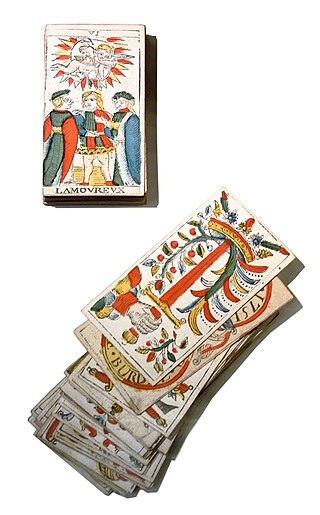
The Tarot of Marseilles is a standard pattern of Italian-suited tarot pack with 78 cards that was very popular in France in the 17th and 18th centuries for playing tarot card games and is still produced today. It was probably created in Milan before spreading to much of France, Switzerland and Northern Italy. The name is sometimes spelt Tarot of Marseille, but the name recommended by the International Playing-Card Society is Tarot de Marseille, although it accepts the two English names as alternatives. It was the pack which led to the occult use of tarot cards, although today bespoke cards are produced for this purpose.

"The Tower of the Elephant" is one of the original short stories starring the fictional sword and sorcery hero Conan the Cimmerian, written by American author Robert E. Howard. Set in the pseudo-historical Hyborian Age, it concerns Conan infiltrating a perilous tower to steal a fabled gem from an evil sorcerer named Yara. Its unique insights into the Hyborian world and atypical science fiction elements have led the story to be considered a classic of Conan lore and is often cited by Howard scholars as one of his best tales.

Brian Haberlin is an American comic book artist, writer, editor and producer. He is best known as the co-creator of the Witchblade franchise and for his digital art style.

Ymir is a fictional character appearing in American comic books published by Marvel Comics. He is based on the frost giant of the same name from Norse mythology.
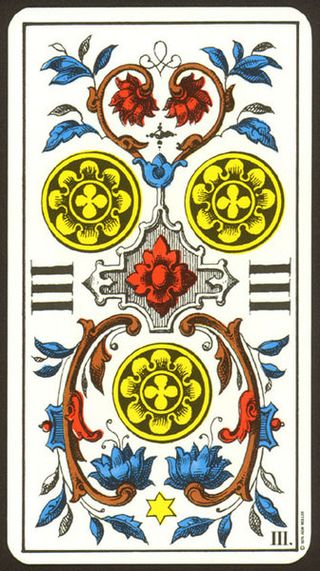
The Suit of Coins is one of the four suits used in tarot decks with Latin-suited cards. It is derived from the suit of coins in Italian and Spanish card playing packs.

Tarot card reading is a form of cartomancy whereby practitioners use tarot cards to purportedly gain insight into the past, present or future. They formulate a question, then draw cards to interpret them for this end. A traditional tarot deck consists of 78 cards, which can be split into two groups, the Major Arcana and Minor Arcana. French-suited playing cards can also be used; as can any card system with suits assigned to identifiable elements.

Tarot games are card games played with tarot decks, that is, decks with numbered permanent trumps parallel to the suit cards. The games and decks which English-speakers call by the French name Tarot are called Tarocchi in the original Italian, Tarock in German and various similar words in other languages. The basic rules first appeared in the manuscript of Martiano da Tortona, written before 1425. The games are known in many variations, mostly cultural and regional.

The Fool is one of the 78 cards in a tarot deck. In tarot card reading, it is one of the 22 Major Arcana, sometimes numbered as 0 or XXII. However, in decks designed for playing traditional tarot card games, it is typically unnumbered, as it is not one of the 21 trump cards and instead serves a unique purpose by itself.
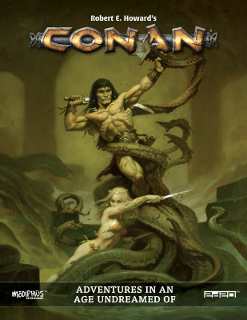
Robert E. Howard's Conan: Adventures in an Age Undreamed Of is a sword and sorcery pen-and-paper role-playing game set in the world of Conan the Barbarian, the fictional Hyborian Age. Both the character and the setting were first imagined by author Robert E. Howard. Howard's original literary work has since spawned a vast franchise of novels, comic books, films, video games, board games, role-playing games, etc. Following this tradition, Conan: Adventures in an Age Undreamed Of is the third officially licensed Conan role-playing game. The two precedent games were Conan Role-Playing Game (1985-1988) and Conan: The Roleplaying Game (2004-2010), although there also had been supplements for independent generic systems, like GURPS Conan (1988-1989).